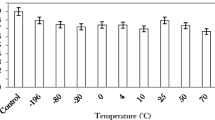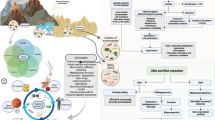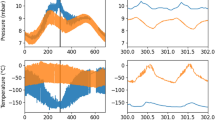Abstract
The Martian Environment Simulator (SAM “Simulatore di Ambiente Marziano”) is a interdisciplinary project of Astrobiology done at University of Padua. The research is aimed to the study of the survival of the microorganisms exposed to the “extreme” planetary environment. The facility has been designed in order to simulate Mars’ environmental conditions in terms of atmospheric pressure, temperature cycles and UV radiation dose. The bacterial cells, contained into dedicated capsules, will be exposed to thermal cycles simulating diurnal and seasonal Martian cycles. The metabolism of the different biological samples will be analysed at different phases of the experiment, to study their survival and eventual activity of protein synthesis (mortality, mutations and capability of DNA reparing). We describe the experimental facility and provide the perspectives of the biological experiments we will perform in order to provide hints on the possibility of life on Mars either autochthonous or imported from Earth.
Similar content being viewed by others
Avoid common mistakes on your manuscript.
A dedicated environmental simulator has been designed and built in order to recreate conditions at Mars’ surface in terms of atmospheric composition, temperature, pressure (Zurek 1993; Hourdin et al. 1993; Gurwell et al. 2005) and UV radiation (Cockell et al. 2000; Córdoba-Jabonero et al. 2005). The simulator consists of an environmental chamber (Figure 1) containing six capsules where the bacterial cells or spores are accommodated. Each capsule is interconnected with a 0.2 μm biological filter and a valve to the main chamber. This configuration makes possible the control of the atmospheric conditions inside the capsules, acting only on the main environmental chamber and allowing the extraction of a single biological sample without perturbing the other ones. The baseplate of the main chamber is equipped with a cooling and heating system for temperature control of all test samples together. The samples are illuminated through a quartz window with a UV lamp (180–300 nm) simulating the diurnal solar flux at Mars (Patel et al. 2004).
During the tests, the biological samples are kept in a controlled atmosphere of a selected gas mixture (mainly CO2) and exposed to thermal cycles simulating daily and seasonal Martian cycles, with temperature ranging from −140°C to more than −20°C and pressure of the order of few mbar (Hourdin et al. 1993). Samples could be removed and changed at different phases of the experiment, for studying temporal variation of the survival.
The bacterial species selected for the experiments belong to the genus Bacillus, Deinococcus and Clostridium. The choice of Bacillus and Clostridium derives from their ability to produce spore, that give them a remarkable resistance to external conditions, while the Deinococcus survives to the exposure to ionizing radiation (even more than 1.5 Mrad), because of his ability to repair the breaks on the double chain of DNA restoring the chromosomic continuity. The metabolism and eventual protein synthesis of the biological samples will be analysed by microscopic electrophoretic and molecular methods.
We do expect these experiments to help for investigating the survival of extremophile lifeforms and prebiotic synthesis and degradation, and also to understand if the possibility of planetary contamination exists. These experiments will allow defining the limits of the lifeforms that may be present on Mars, either autochthonous or imported from Earth by our landers, and may provide hints on the origin of life on Mars.
The facility will also be available for collaborations with scientists of various fields (biologists, geologists, etc.) interested in performing experiments in very extreme environments, like that of Mars or of some regions of the Earth like Antarctica.
References
Córdoba-Jabonero et al (2005) Icarus 175:360
Cockell CS et al (2000) Icarus 146:343–359
Gurwell et al (2005) Icarus 175:23
Hourdin F et al (1993) J Atmos Sci 50:3625–3640
Patel MR et al (2004) Icarus 168:93–115
Zurek RW (1993) In: Kieffer et al (ed) Mars. University of Arizona Press, Tucson, AZ
Acknowledgements
This work has been funded by the University of Padova as Progetto di Ateneo 2003.
Author information
Authors and Affiliations
Corresponding author
Rights and permissions
About this article
Cite this article
Galletta, G., Ferri, F., Fanti, G. et al. S.A.M., the Italian Martian Simulation Chamber. Orig Life Evol Biosph 36, 625–627 (2006). https://doi.org/10.1007/s11084-006-9046-1
Published:
Issue Date:
DOI: https://doi.org/10.1007/s11084-006-9046-1





